Every spirit category has its shortlist of producers that are at the summit of the quality pyramid for that particular spirit. I will refrain from listing additional names here, but Vallein Tercinier is without a doubt one of those producers occupying a solid position at the peak for Cognac. Their Cognac production covers all one could hope for, whether it be traditional blends or unique single cask bottlings.
Consequently, they cater to Cognac and spirits amateurs regardless of where they are in their spirits journey. Whether you wish for an accessible and balanced blend (VSOP, Napoleon, XO, etc.) or a precise and intense cask strength bottling, Vallein Tercinier has you covered.
The quality is high; the packaging is humble and true; the pricing is more than fair, and the memories procured from having their Cognacs in your glass is potentially priceless. On deck this month are the three new Vallein Tercinier Très Vieux Cognac Brut de Fût bottlings: Single Cask 1990 Bons Bois, Single Cask 1989 Grande Champagne, and Single Cask Lot 96 Fins Bois.
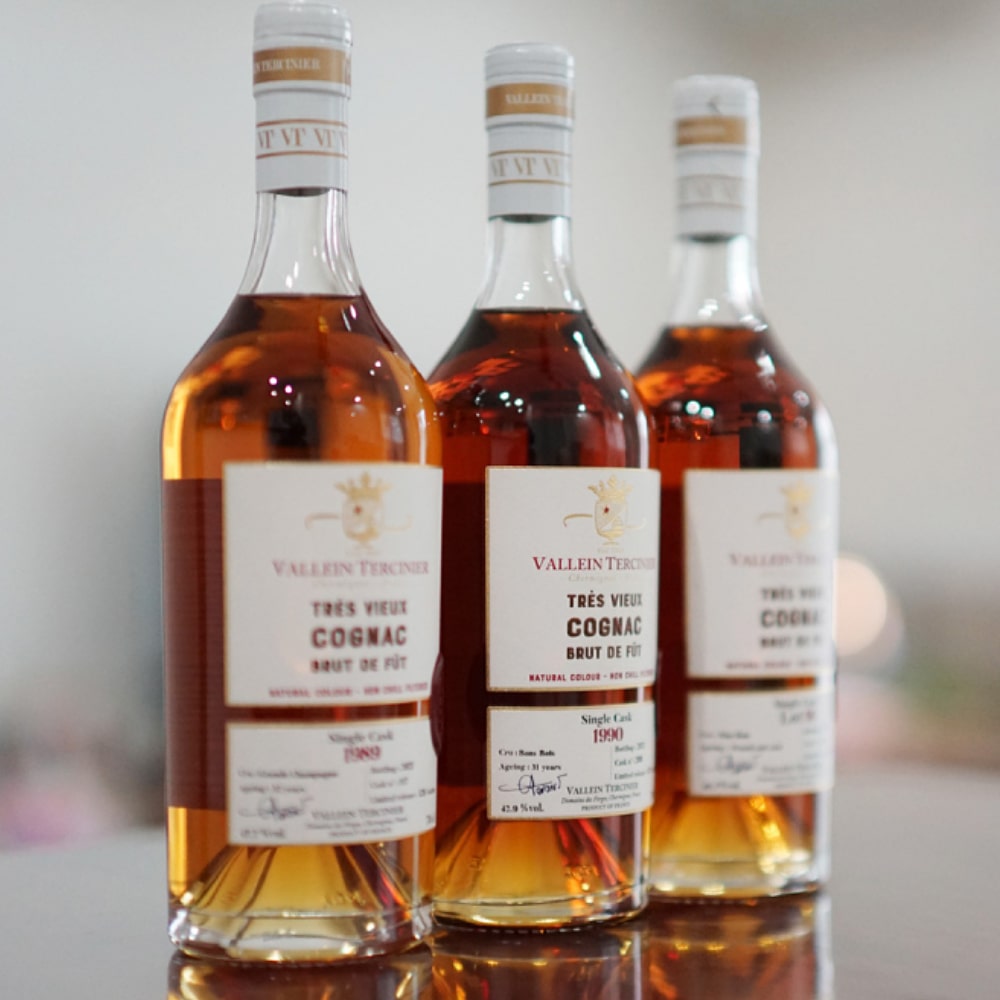
Writing a review and other commentary is of course a subjective endeavor, despite any writer’s aims at objectivity. Still though, before even unwrapping the foil sleevers, I pinched myself to make sure to focus on rating what’s in front of me. I’m supposed to like these Cognacs, and a preconceived urge inside me wants me to like these very much. Nevertheless, I hope to have shelved those sentiments to evaluate these Cognacs as I would any other Cognac, from any other producer.
Production Details
As indicated just above, all three Cognacs are Single Cask Brut de Fût (cask strength) bottlings. Brut de Fût is an indication that the Cognac’s alcohol level reduced to its bottling ABV naturally over the years in the cellar, without the addition of water. The color is natural, and each was non chill-filtered.
The 1990 Bons Bois and the 1989 Grande Champagne are official vintage Cognacs, whereas the Lot 96 Fins Bois is an unofficial vintage Cognac – hence the presence of the word “Lot 96” and not the actual year 1996. Anytime one tastes a vintage or unofficial vintage Cognac, it’s important to know when the Cognac was put into bottle, or some other glass container, since the Cognac ceases to evolve once in glass. For all three of these Cognacs, bottling occurred in the summer of 2021. Moreover, the front and back labels contain a wealth of meaningful production information that is summarized in the table below:
| Cognac | Cru | ABV% | Age | Cask Number | Bottles Produced |
| 1990 Bons Bois | Bons Bois | 42.9% | 31 years | 205 | 571 |
| 1989 Grande Champagne | Grande Champagne | 47.7% | 32 years | 117 | 328 |
| Lot 96 Fins Bois | Fins Bois | 48.7% | 25 years | 138 | 435 |
Needless to say, this is a promising start.
Bottle Presentation & Packaging
Anyone who has owned or otherwise tasted any of Vallein Tercinier’s previous Single Cask bottlings will immediately notice that the bottle design has been changed, and the labels have received a visual overhaul. In the past, the classic Charentais bottle form was used, a bottle shape I love for its charming simplicity and regional identity. Now, it has been replaced by a hybrid more squat, voluminous Charentais bottle shape. It’s almost as if someone compressed the old bottle to give it a larger waistband, and an overall fatter look.
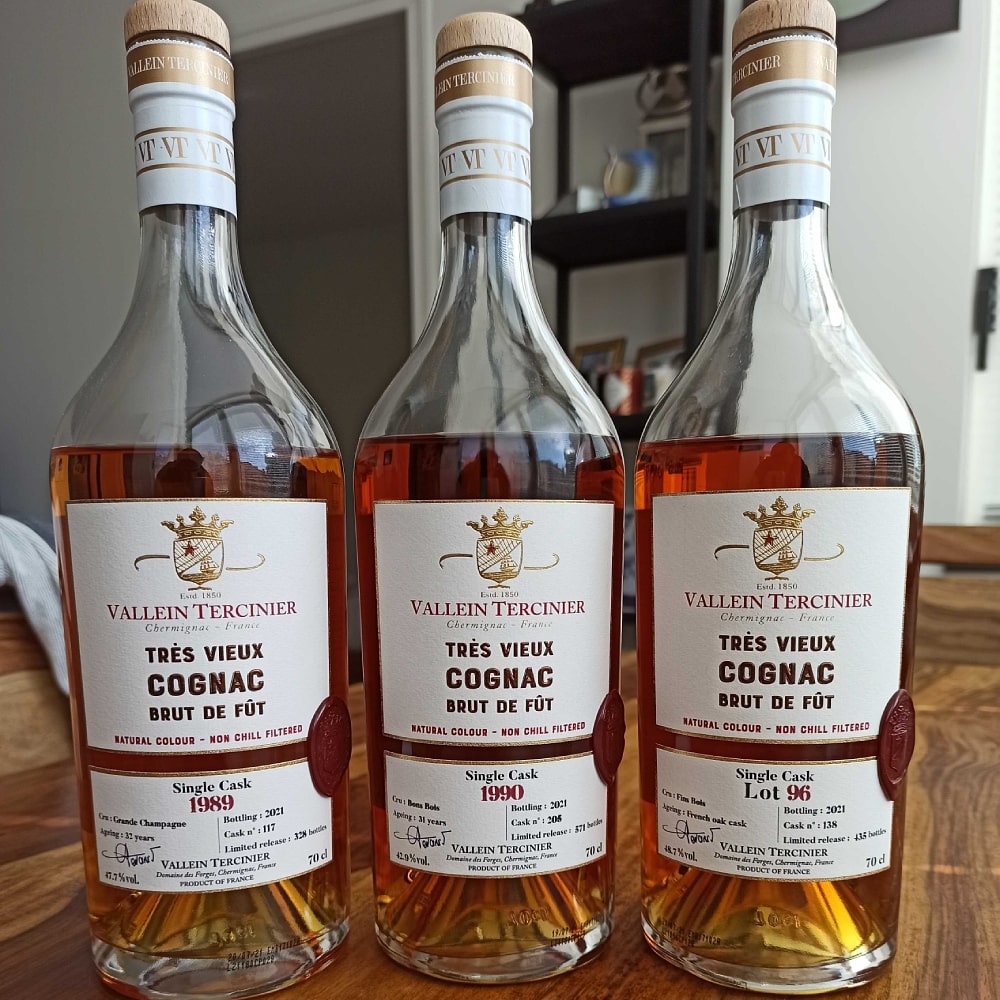
As a result, the bottle feels more solid in the hand and more imposing on the table. I also have to believe that Vallein Tercinier made this bottle change to accommodate larger, more informationally-loaded front and back labels. The bottle form change makes sense and does not veer far enough away from the classic bottle for me to take issue with it. This is a positive and smart change.
The labels have been relooked too. As the photos will show, the front label actually consists of two parts, a top section with general producer information and a smaller bottom section containing the specific production details for that Cognac. The overall look is bigger, whiter, sharper, cleaner, and more modern.
The producer logo sits comfortably at the top in an elegant gold print and the producer name is in a crisp red font. The “Tres Vieux Cognac Brut de Fût” is now in a bolded blocky modern font. Honestly, the label pops more now compared to the vintage charm of the previous labels.
The bottom production-oriented label gives all of the main details stated in the table above. Both labels are sealed together with a deep red wax and stamped with the Vallein Tercinier seal. And last but not least, the signature on the bottom acts as a final seal of approval from Vallein Tercinier’s master blender. I personally love that touch, as it serves as a gentle reminder of the people behind these bottles.
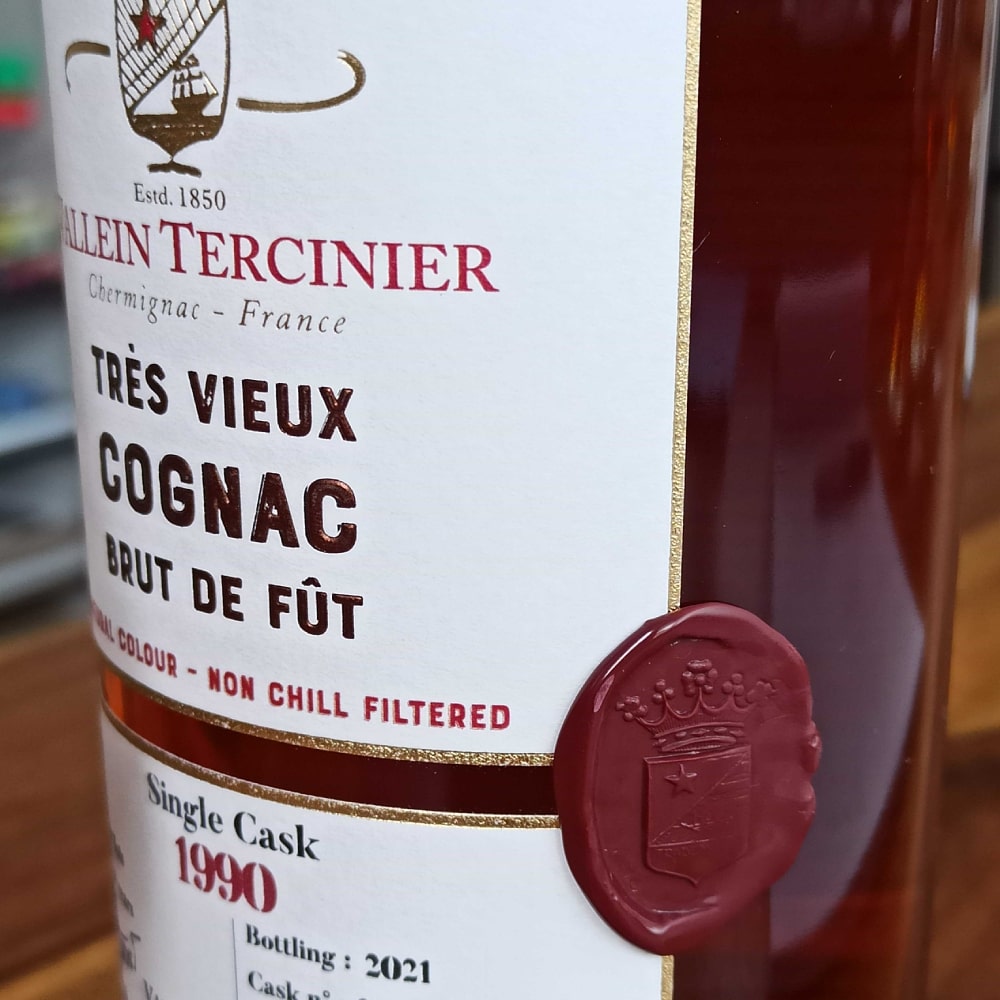
The back label contains detailed tasting notes in French and English, in addition to the bottling month and year. As my eyes drift away from the label, I notice a date and code laser printed at the very bottom of the bottle. I could easily assume this is an exact bottling date. I must say, bravo Vallein Tercinier for including just about all information a taster seeking these types of bottles would want to hear. And for those who are just getting into these Single Cask bottlings, the inclusion of this information will get them to ask interesting questions and increase his or her Cognac knowledge and appreciation.
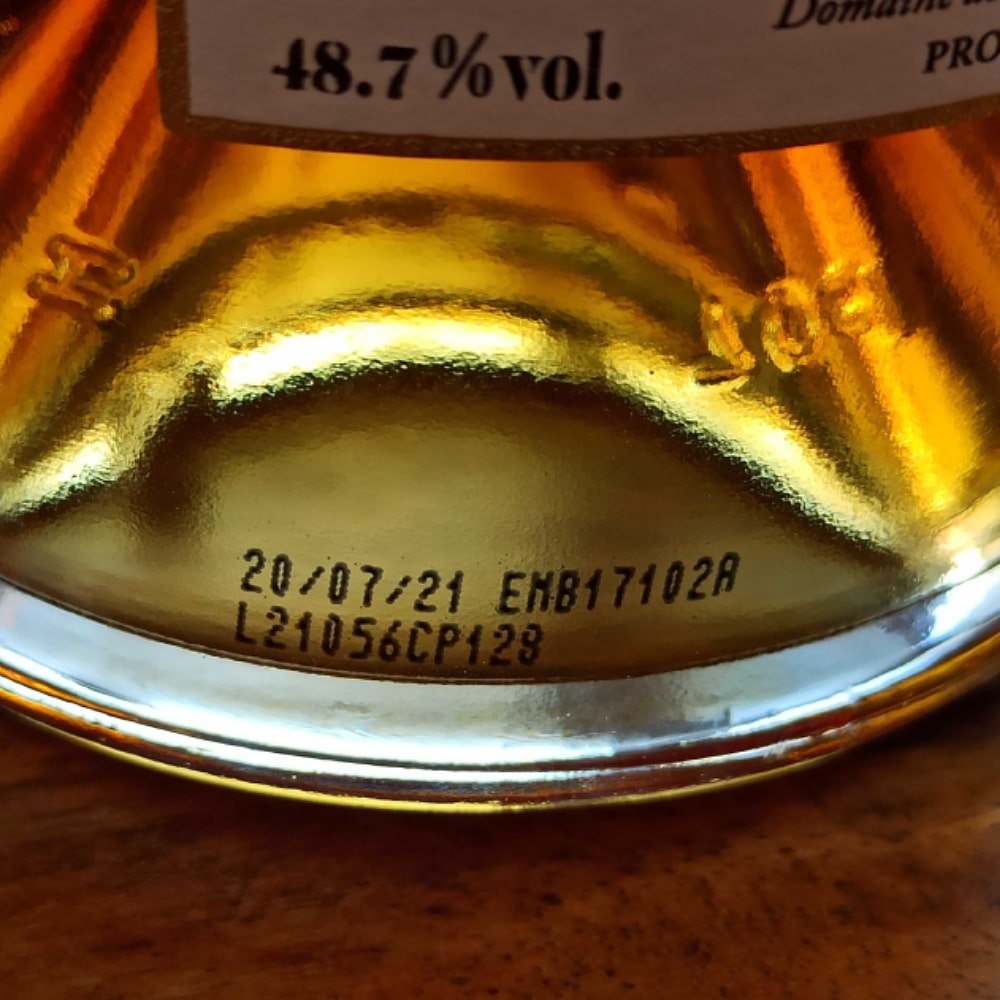
Please allow me to split hairs for a brief moment. If Vallein Tercinier is going to go all the way and give virtually all production information, why not also state the cellar conditions (humid or dry) and actual information about the cask. I would prefer information about cask provenance and grain over cask number; it’s just more meaningful and useful for me. But again, I’m splitting the thinnest of hairs here.
Lastly, Vallein Tercinier has garnered quite a bit of attention from the general spirits community over the years. In addition to making fantastic honest Cognacs, they are doing all the right things in how they label and how they present their Cognacs. Spirits enthusiasts have taken notice. But I have observed skepticism and reluctance from whisky lovers, for example, whenever their favorite whisky brands change labels and bottle shapes.
Many refer to it as a “rebrand” and look down on it since the common understanding is that the producer is changing the bottle presentation in addition to an adjustment in the age and/or quality of the spirit inside the bottle – and not for the older, and not for the better. Read online reaction about the recent Old Pulteney or Benromach label redesigns; it’s less than stellar.
I mention this to raise a defense for Vallein Tercinier in case they have to deflect any negative reaction to their label redesign and bottle change from the increasing attention they receive from the whisky and general spirits community. In my opinion, the redesign has modernized the labels to make them attractive to a wider spirits audience that may only just now be tiptoeing into Cognac. Also, the new label design provides even more production information than before. Third, the change in look in no way suggests a shift in age or quality. These are single cask bottlings.
There is no formula, no blend to adjust here. I’ve seen a few online “rebrand” comments aimed at Vallein Tercinier when these bottles first came out. It’s more apt to call this a label redesign, and not a rebrand since the Tercinier brand has not been overhauled here. That all being said, of course, we are all free to agree or disagree on matters of style. Anyways, I digress.
Tasting Conditions
The following bullet points list gives a few details on how the tasting notes to follow were constructed:
- All three Cognacs were tasted alongside one another over a period of six non-consecutive days
- Glass: Lehmann Eau de Vie 15
- A “control” Cognac was included in each tasting, control Cognac at 40% ABV. Despite the bottles focused on this review all being higher proof, the control Cognac served a purpose and was not overpowered by the Tercinier Cognacs.
- Tasting duration: 45 minutes to 70 minutes
- A personally-adjusted printed Cognac Aroma Wheel was by my side for each tasting
It ‘s about time to taste some Cognac. I’ve written it before and I’ll write it again here now: The only thing that really matters is what’s in the glass.
Tasting Notes
Vallein Tercinier Single Cask 1990 Bons Bois
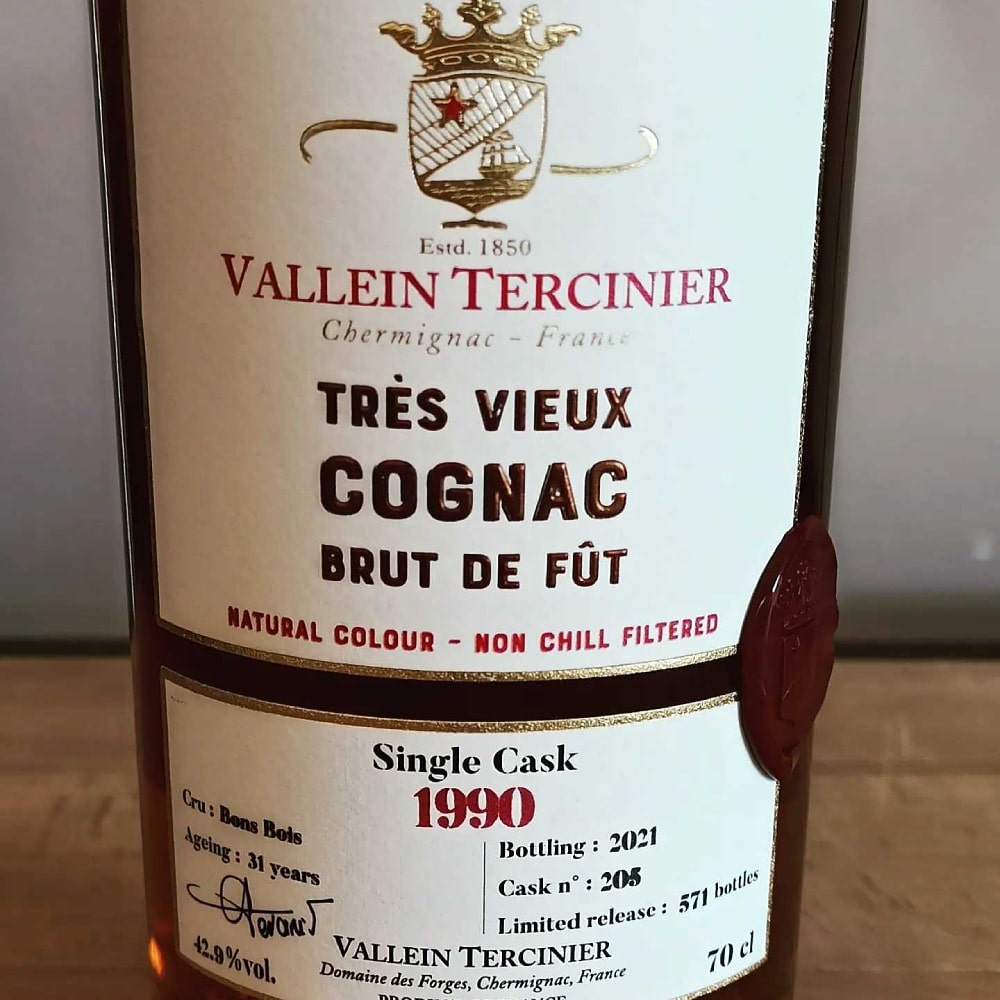
Eye: Amber. Like most Brut de Fût Cognacs, this Cognac leaves a thick-ish disk on the glass as the glass walls are coated. Consistent slow moving legs crawl down the glass.
Nose: Dipping my nose into the glass, I immediately get notes of vanilla and creamy black licorice. With just a few minutes of air, the Cognac gets quite patissier – a word I’ve used in the past to suggest all things dessert-oriented. What comes to mind are financiers, canelé dough, madeleines, and crème brûlée.
So imagine a wave of those unmistakable French dessert pastry notes, specifically ones with a heavy dose of almond powder. There are fruit notes lurking in the distance, but they are more of the candied and caramelized varieties: candied figs, plums and apricots.
With even more time in the glass, the aromas get a little musky, which is a positive thing. I’d classify the nose as quite obvious in that everything’s right there in front of you. It’s complex and balanced, yet relatively easy to understand. For a single cask Brut de Fût bottling, the smells alone are incredibly accessible and inviting.
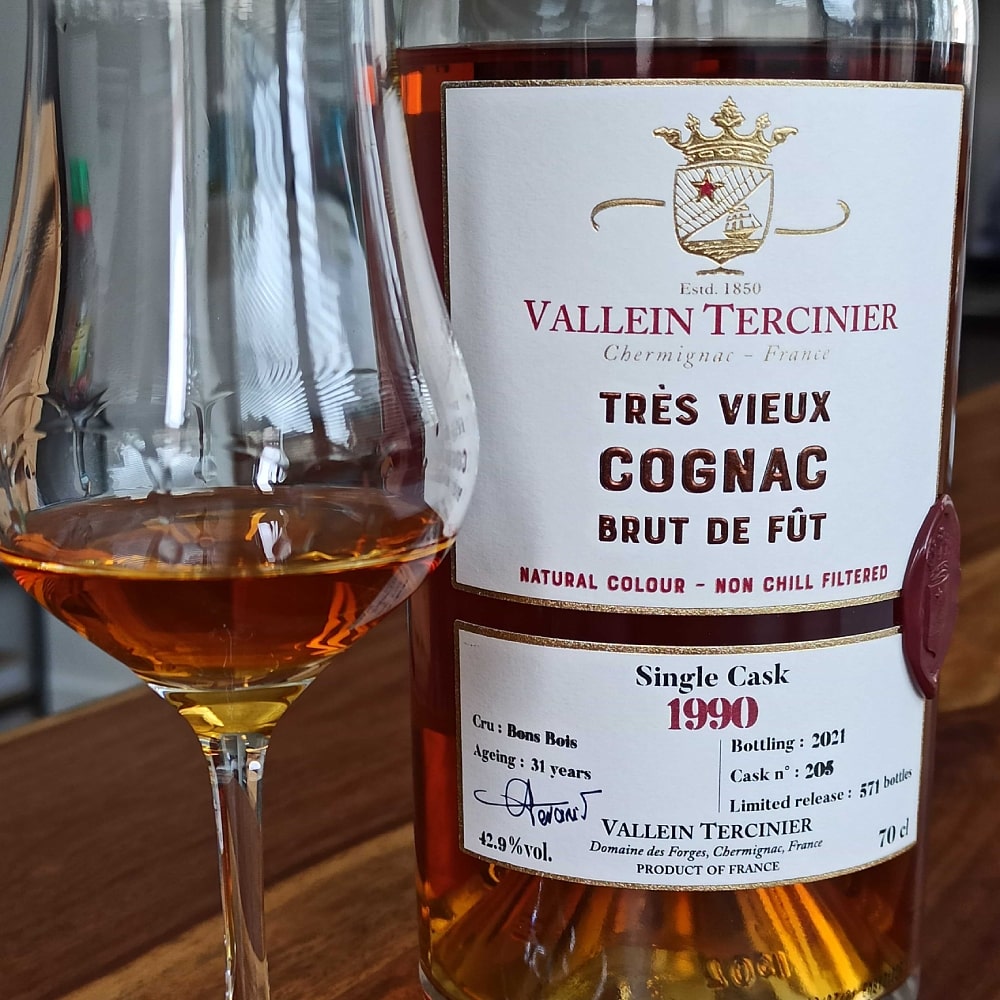
Palate: Melted: the first word I uttered after swallowing a sip. I think of a melted Cognac as one whose flavors have all integrated to create a sum which is better than the parts. The flavors to be listed are all present but not one of them stands out, or leads the way.
For sake of analogy, think of soups and other braised dishes that always seem to improve on day two, after a night and half a day in the fridge. Their flavors melt and work better together as one integrated unit after some settling time. And while each individual ingredient flavor is harder to pick out, it’s clear they are all there contributing something. That’s what’s going on with this Cognac – it’s melted.
So about those flavors, I taste vanilla, canelé, rum and raisin ice cream, licorice, and the candied fruits mentioned above. Overall, the palate is tremendously composed and in full balance. It comes off as a masterfully blended XO or Extra or Hors d’Age bottling. What a compliment since it says a lot about the inherent quality of the eaux-de-vie when a single barrel Brut de Fût comes off as a skillful blend.
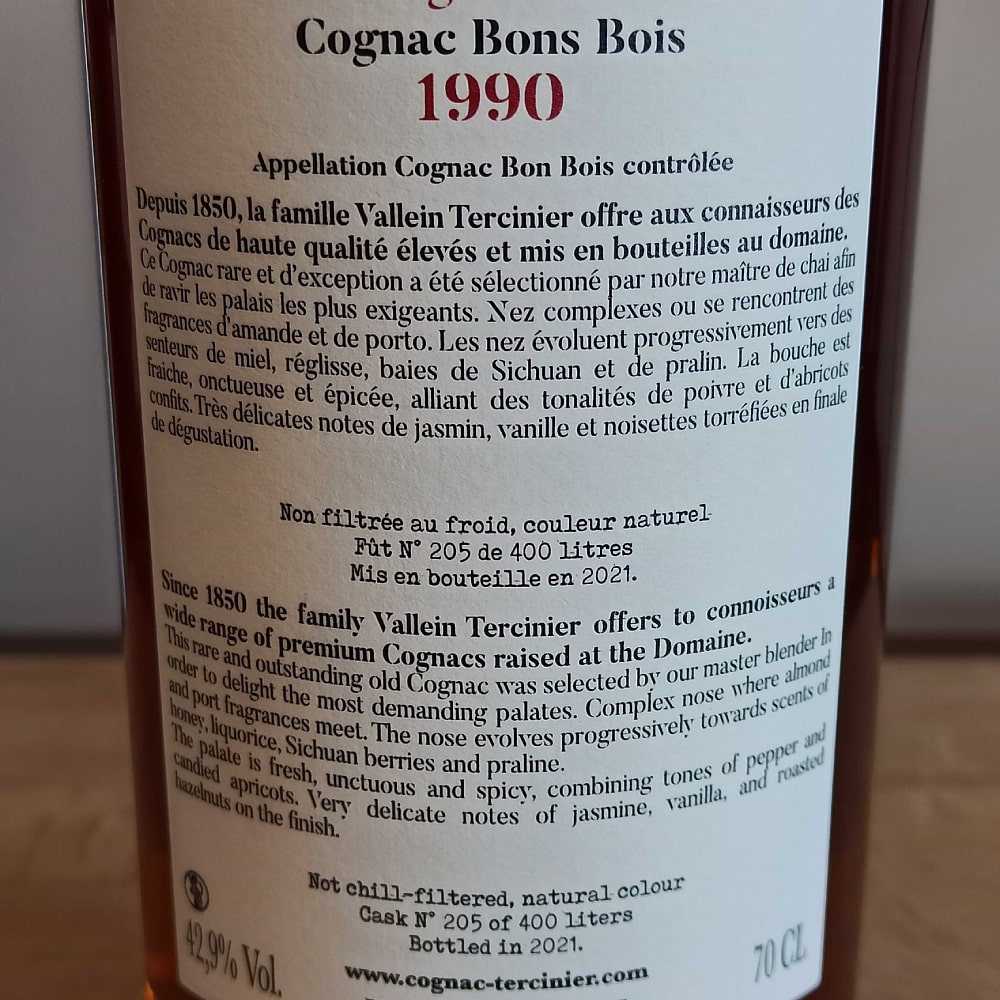
Finish: The finish is where I’d say its cask strength nature returns to remind the taster of what he or she is tasting. There is a slight grip on the finish and an overall impression of something bittersweet. To be clear, there is no oak force as in last month’s Mauxion Bons Bois Multimillesime, but the oak can be felt and the Cognac’s underlying intensity kicks in at the end. It’s really very lovely and a great gateway to overproof Cognac.
Vallein Tercinier Single Cask 1989 Grande Champagne
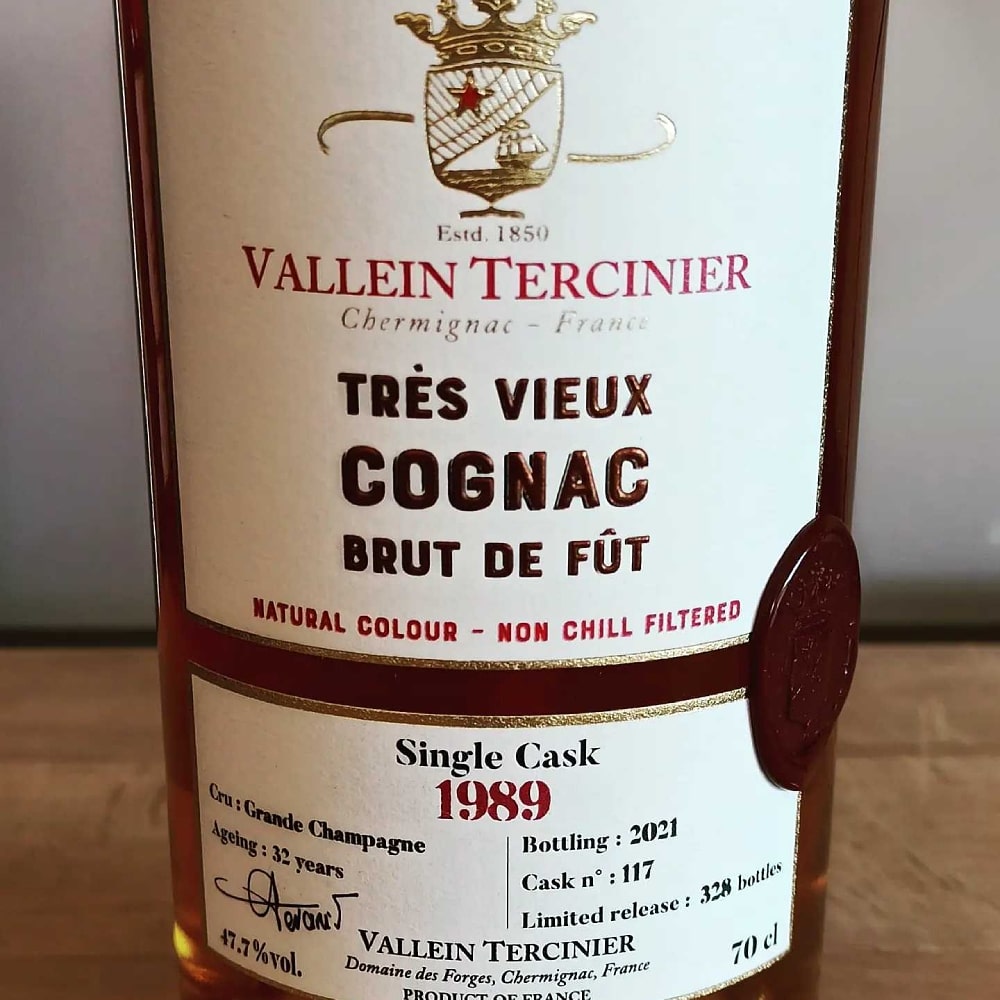
Eye: Light and bright amber with orange tints and reflections. This is the lightest Cognac of the three bottles. Coating the glass’ walls leaves a film of Cognac that casts legs, but they are more hesitant to drip down the glass this time. This should be bigger and fuller.
Nose: The nose is immensely fruity. Imagine crystal clear, chiseled fresh, candied, and jammy fruits in all shapes and sizes. Apricots, spiced orange peel, tinned mandarins, tinned peaches, and fresh ripe mango. It smells so pure and clean. A Cognac with this nose tiptoes into the extreme finesse territory. With time in the glass, exotic spice notes from the oak make themselves apparent, but I just keep coming back to the fresh fruity nature of this one. A fine VSOP can be fresh and fruity too, but this one exudes a real sense of maturity. High level stuff.
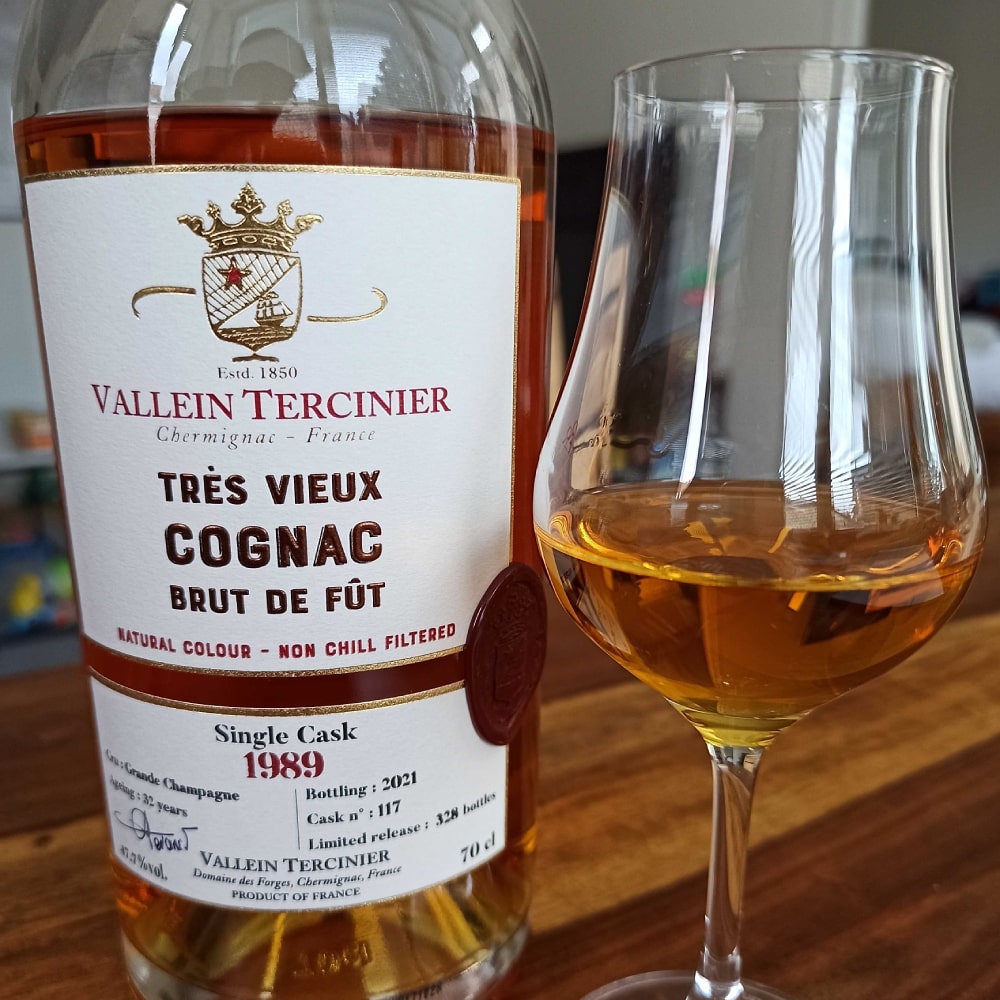
Palate: The Cognac is mouth coating. It’s full, round, and yet in perfect balance. Nothing, and I mean nothing is off here. There’s the bags and bags of fruit: spiced orange citrus, apricot, tangerine, tinned peaches, and mangos. There’s the syrupy oily texture. There’s the intensity and grip. And despite the high ABV, there is nothing edgy about swirling this one in the mouth. It’s as precise as a laser beam and is an all around complete Cognac.
Earlier, I mentioned that writing a review is a subjective endeavor. Well, I’d venture to guess that if you lined these three Single Cask Cognacs up and asked 100 tasters which one is the most complete Cognac, 99 out of 100 would select this bottle out of the three in this review. It might not be everyone’s most preferred – it’s not for me, more on that below – but there is no denying that this 1989 Grande Champagne has it all. There is nothing to take issue with. It flirts with Cognacs at the highest level.

Finish: The finish is memorable in that it just lingers, refusing to go away. In each of the tasting sessions I held for these three bottles, I tasted in ascending order of ABV (the 1989 places second in that order). I had to force myself to slow down before moving on to the Lot 96 Fins Bois since this 1989 Grande Champagne was just so long. In reality, I just took a sip of water and moved on, but a taster that rushes through this one will miss out on the experience of the finish. It’s like a gift that keeps on giving. Lastly, this bottle is proof of the heights that can be reached when producers get it right with single cask Brut de Fût bottlings.
Vallein Tercinier Single Cask Lot 96 Fins Bois
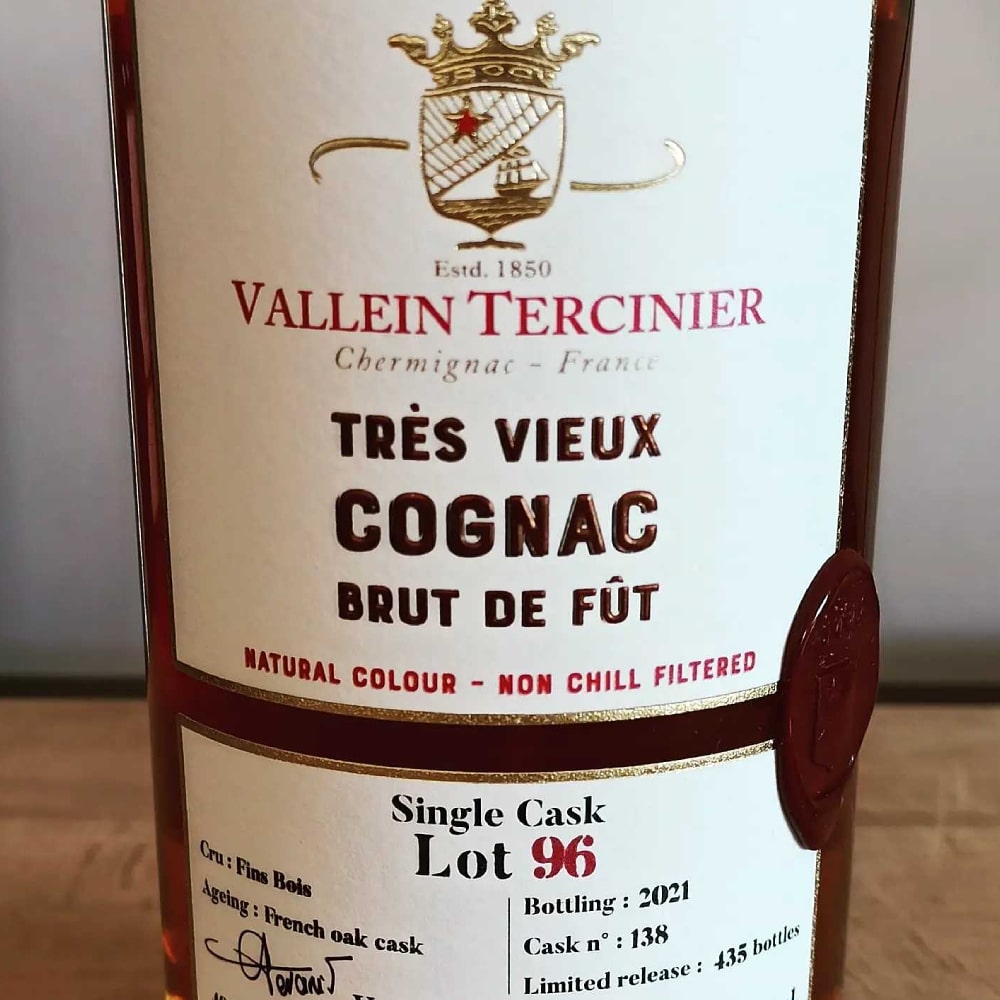
Eye: Deep amber. As I coat the glass walls, this seems to be the thickest and fullest of the bunch.
Nose: The chiseled fruits are back but now they are fatter, denser and seem to ooze out of the glass. I smell apricots, ripe melons, plums, and sweet candied citrus. Something about the nose carries with it a sweet sugary confectionery note, like walking in an artisanal candy store. Then, after about twenty minutes, an earthy spicy orange cologne perfume enters. What immediately flashed through my mind was Terre d’Hermes eau de toilette or eau de parfum.
Now does this Cognac really smell like a Hermes perfume? I can’t be entirely sure since I’ve never smelled them side by side, but I keep telling myself there must be something there if that unique perfume smell entered my mind once this Cognac received adequate air. It’s highly aromatic; It’s a sultry and sexy nose.
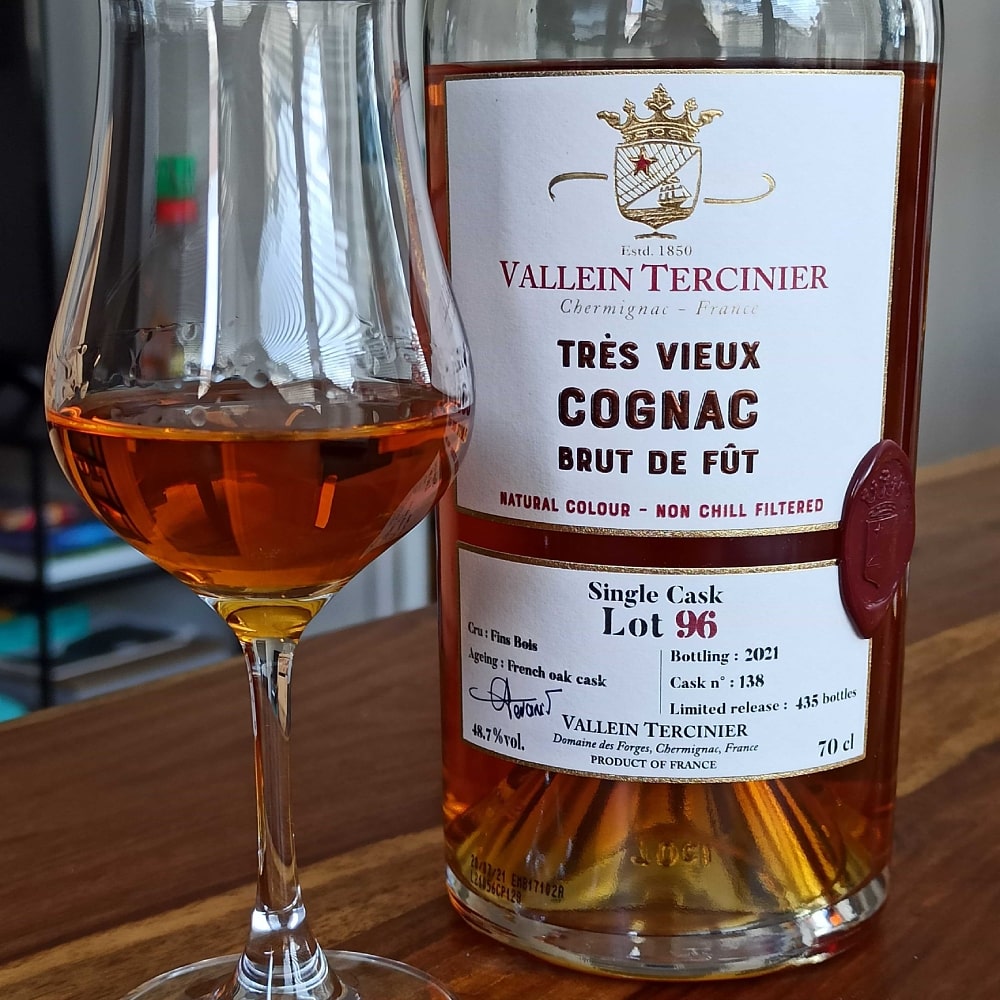
Palate: The fatness on the nose immediately carries over into the mouth. This is the fullest and densest Cognac of the lot. Perhaps this big cushioned oozy texture comes at the expense of precision, but it’s just so fine to taste. So yes, I’m openly admitting this does not have the same precision and complete balance as the 1989 Grande Champagne. That being said, the aforementioned fruits are there in spades. Moreover, the fruit flavors are also accompanied by flavors of sugary sweets, precious woods and incense, and exotic perfumes. It all feels more exotic and oriental.
As I swish the Cognac around in the mouth, my mouth literally waters. And this is what I find fascinating about this Cognac: how can such a fat oozy Cognac make my mouth water so much? I typically associate the mouth watering sensation with things that are acidic, like a fine riesling from Alsace or a Sauvignon Blanc from the Loire. But here the contrast between the beguiling aromas, the heft of the spirit, and the fresh thirst quenching nature get me excited. Fascinating!
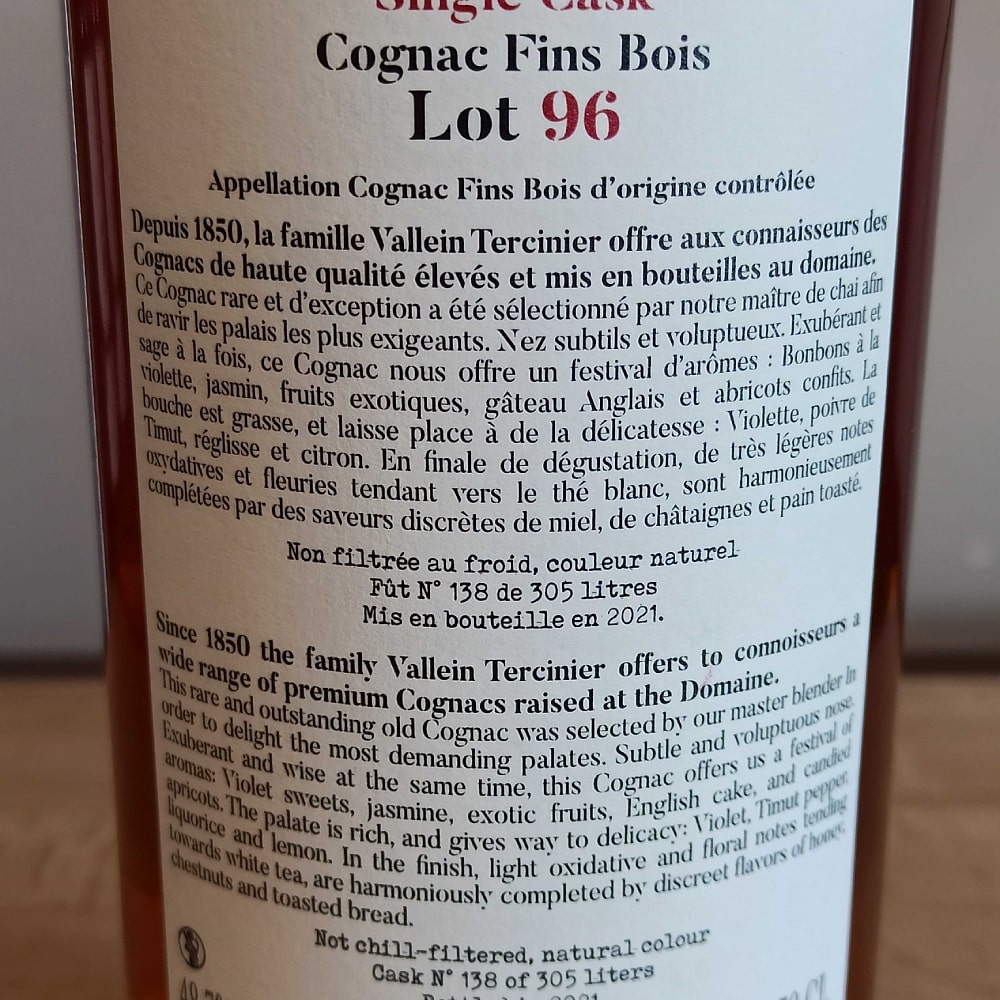
Finish: The finish carries with it some force and heat. There is nothing rustic or edgy, thankfully. Remember, the force and heat is mainly felt on the first sip or two. By the time you’ve gotten past the first two sips, the palate is calibrated and the pleasure grows exponentially. The flavors linger long enough for me to get as much out of them as possible before moving on to the next sip. This is not the most complete Cognac of the group, nor is it the most accessible one of the tasting, but it is my favorite, whatever that’s worth.
Conclusions
I’ll conclude with some words about who these Cognacs are for and the reasons for which I would consider making them a part of my personal collection.
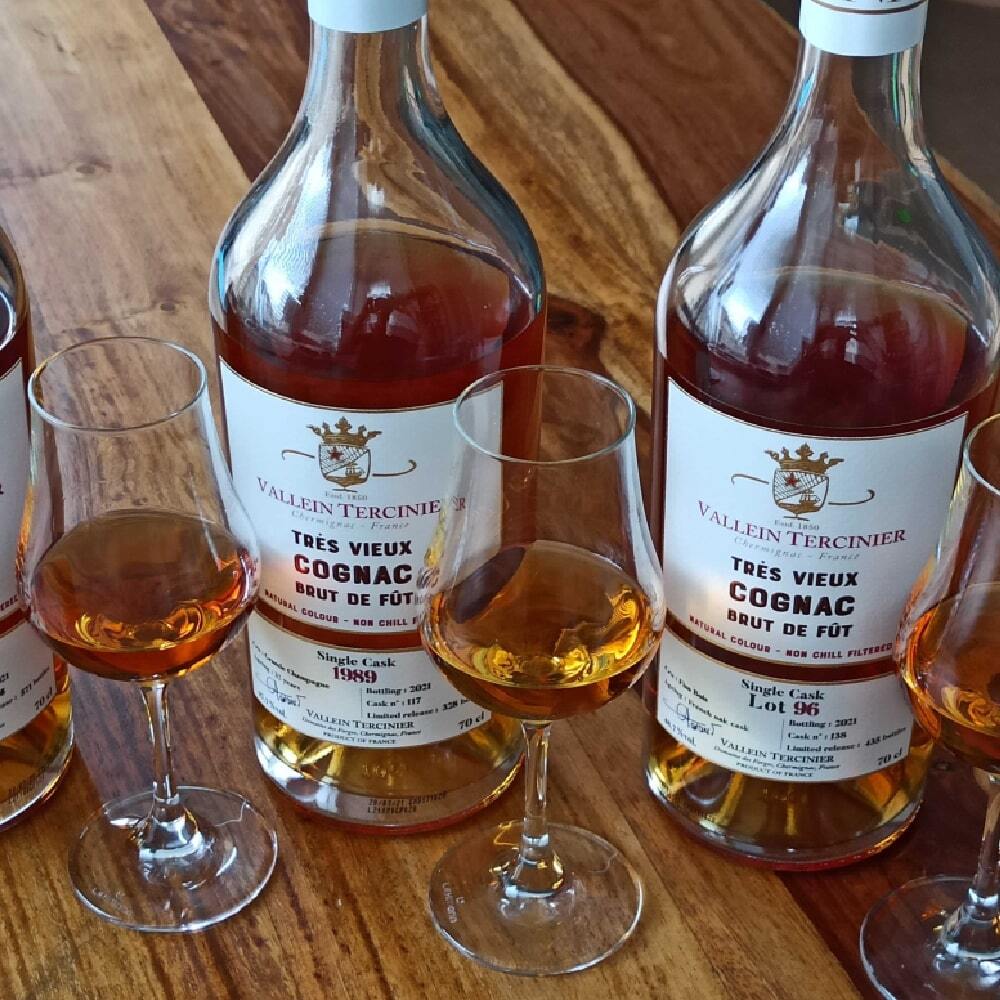
The 1990 Bons Bois Single Cask is the most obvious and familiar bottle of the three. Despite being a single barrel Brut de Fût bottling, it gives off an impression of being a well made blend due to its ease and its balance, quite a remarkable feat for an eau-de-vie that saw no blending or manipulation in the cellar whatsoever. If I were curious about these cask strength naturally reduced bottlings but was slightly hesitant at the higher proofs, this would be the bottle to opt for due to its ease of access. I love a nice Bons Bois too. To check it out, head to the product page here.
The 1989 Grande Champagne Single Cask rubs elbows with Cognacs at the highest level. It is a complete Cognac; if you find a fault with this Cognac, please send me an email. Kidding aside, the coherence between the nose, palate, and finish is perfect. I’d buy this if I wanted to see what the Grande Champagne is capable of at a medium level of maturity. And get this if you want to taste what all of the Brut de Fût buzz is all about. Fine fine Cognac here! To taste single cask perfection – almost – click the link here.
The Lot 96 Fins Bois is a seductive, sexy Cognac. The nose is otherworldly with its exotic and oriental aromas and the mouthfeel lingers in my memory due to its fat texture and fresh mouthwatering nature. The tension between the suave poised nose and the extroverted palate makes for an exciting tasting experience. I love this! To smell this and taste a Cognac of real texture, stop by the product page here.
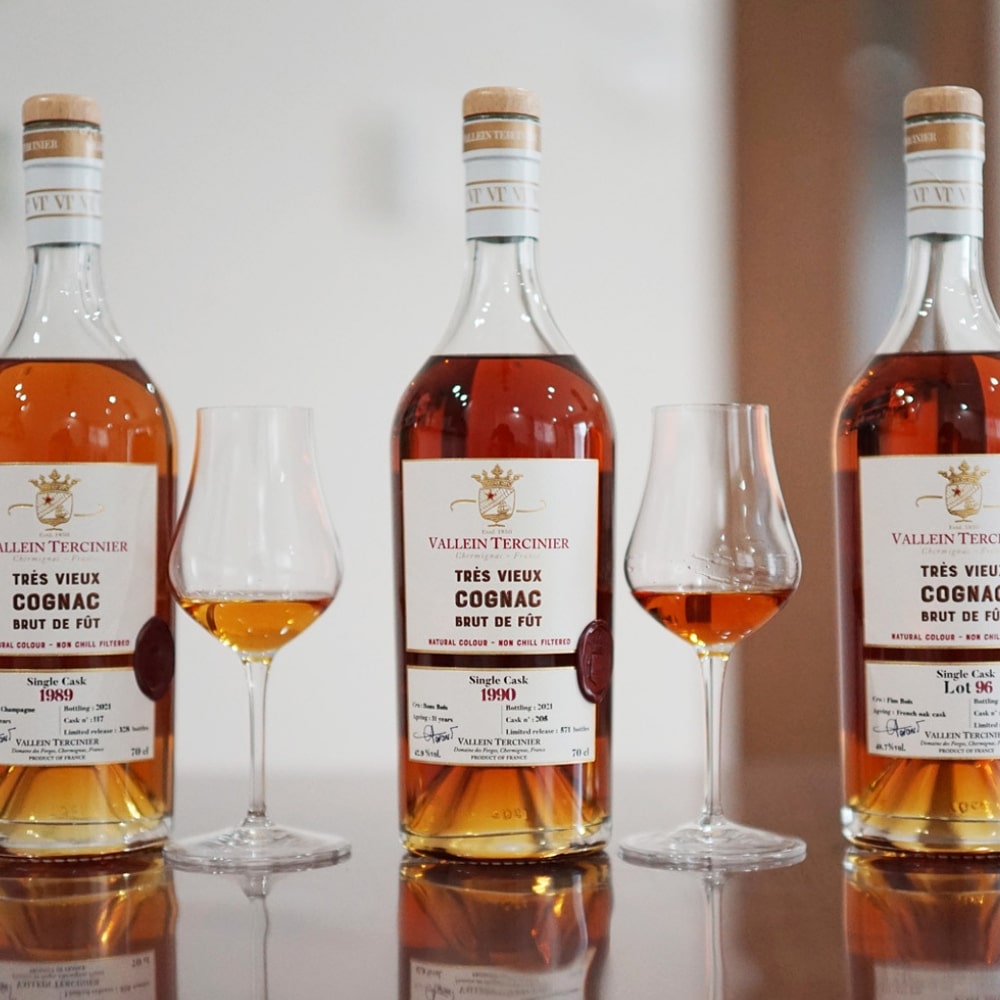
Bravo Vallein Tercinier! Merci for bottling these Cognacs. And perhaps most importantly, thank you for the future memories that will be created around the table as I enjoy these bottles with those I hold dear.
Credit goes to Brandy Daddy from our japanese Blog for providing some of the used images.







